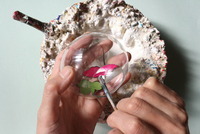

Total:131items
- Pottery & Porcelain (18)
- Lacquerware (4)
- Glasswork (2)
- Wood & Bamboo Work (19)
- Leather Work (1)
- Papermaking (13)
- Textile (20)
- Dyeing products (5)
- Masonry (1)
- Metal Work (11)
- Stationery (4)
- Livingware (3)
- Accessory (4)
- Toys & Entertainment (14)
- Interior (2)
- Other crafts (10)

 |
Main Production Site:Tokyo |
 《Characteristics》
《Characteristics》Edo Furin is the name of the glass wind chimes which have been made since the Edo period (17-19c). Yoshiharu Shinohara, fifth generation of the Edo Furin craftsman, named the glass wind bell "Edo Furin" based on references in 1950s. Until then, glass wind chimes were called "Garasu (glass) Furin" or "Bidoro Furin (Bidoro was the term for glass used in the Edo period: originally vidro in Portuguese.)"
As Edo Furins are all hand-made one by one, each Furin has a different sound even though they have the same shape and pattern. Also, to improve sound quality, the edges are intentionally left un-smoothed. Please handle it carefully not to get a cut.
As you can see from the Japanese words fuzei, fuga, and fushu (fu means wind in Japanese and those words all mean taste), the Japanese have been moved by the beauty of the "wind". Especially the wind chimes, which change a wind into refreshing sounds, have been the essentials of hot and humid Japanese summer. Today, they are reevaluated as distinct interior ornaments.
[Traditional Craft in Tokyo]
Information provided by Shinohara Furin Hompo
Translated by: Mie Nakajima, reviewed by Marie Mine

| Materials | Glass |
|---|---|
| Crafting Processes | 1. Winding molten glass up
Glass is molten in a crucible buried in a furnace at a temperature of around 1,320 degrees Celsius. A molten portion of glass is spooled at one end of the blowpipe called tomozao to make a glass blob about the size of a one-yen coin (approximately two centimeters). The glass blob is called kuchidama. 2. Gathering more glass More molten glass is wound up on the kuchidama. This parts will be the body of a wind chime itself. 3. Making a hole The body of the wind chime is slightly inflated with the blowpipe and a tiny hole is made at the top with a wire to be threaded later. 4. Shaping Finally, the body of the wind chime is inflated in one breath. The way of inflating and shaping glass without using molds is called chubuki (free-blowing) in Japanese. Shinohara Furins (Edo Furins) are all made by this process. 5. Cutting The glass becomes cool enough to touch after approximately 20 minutes. The kuchidama is cut down. The edge of the glass where the wind creates sounds is left rough. This is because a smooth edge like a rim of a cup does not produce sounds. 6. Painting Motifs or patterns are drawn inside of the wind chime with a paint brush. After a sound check, the wind chime is completed. |
| History | Middle of the Edo period (17c)
Bidoro craftsmen from Nagasaki (Southern Japan) demonstrated bidoros (toys made of glass) making in Edo (present day Tokyo). Glass wind chimes were introduced into Edo. End of the Edo period (19c) Merchants from Edo learned the techniques of wind chime manufacturing in Nagasaki. They started to sell glass wind chimes at a low price and spread them all over Edo. According to a tradition, Sakurai, a lower-ranked vassal of a shogun (general in the Edo period), passed on the techniques to "Dekomatsu (real name unknown)." Then these techniques were passed down to Sakai Glass and Matahei Shinohara successively. Beginning of the Showa period (late 1920s-1930s) Yoshiharu Shinohara learned the techniques of Edo Furin manufacturing from his father Matahei. After that, he improved his skills and became an authority on Edo Furin. Apart from him, there are only a few craftsmen passing on the traditional skills nowadays. Today Yoshiharu has been striving to make Edo Furin with his successors; his granddaughters Yukari and Hisana. |
| Related URL | http://www.edofurin.com/ |
◆Exhibition / Showcase
Shinohara Furin Hompo Ltd.
Address: 4-22-5 Minami Shinozaki-Town, Edogawa-City, Tokyo 113-0065
Telephone: +81(0)3-3670-2512 (Japanese Only)
Fax: +81(0)3-3677-2552 (Japanese Only)
Closed on Sundays (Occasionally closed on Japanese national holidays)
◆Event Information
Free Tours (Japanese Only)
Tours on glass blowing and painting are available except in the busiest season (July to early September).
Hands-on Workshop (Japanese Only)
1) Painting Only: Approx. 1 hour (1-60 people) for 1,200 yen/person
2) Glass-blowing and painting: Approx. 1 hour (up to 10 people), 1.75h (up to 30 people) for 1,700 yen/person
Assistance needed? For inquiries in English:
JTCO Contact Form
Your inquiries will be forwarded by JTCO in Japanese to the organization you wish to contact.
*Please write the name of craft you wish to ask about.



